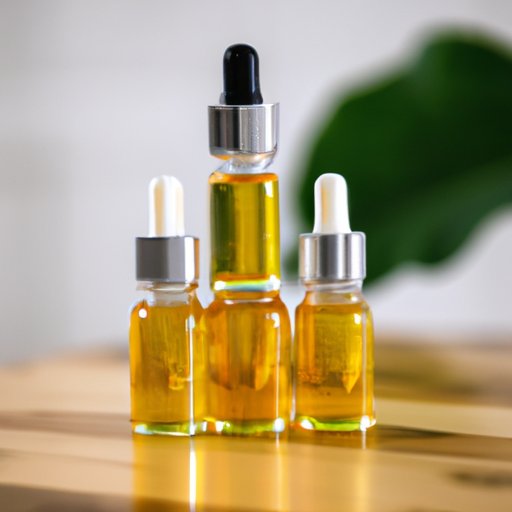I. Introduction
CBD oil has gained immense popularity in recent years owing to its various health benefits. However, buying it can get quite expensive, especially for those who need to consume it daily. Fortunately, you can make CBD oil at home with just a few ingredients and tools. In this article, we will take you through a step-by-step guide on how to make CBD oil at home.
II. Step-by-step guide
To make CBD oil at home, you will need to extract and decarboxylate cannabis. Here is a step-by-step guide on how to do it yourself:
Selecting the appropriate cannabis strain
The first step in making CBD oil is selecting the right cannabis strain. Choose a high-CBD, low-THC strain. CBD is non-psychoactive, meaning it won’t make you high, while THC is responsible for intoxicating effects. You can find strains with balanced cannabinoid profiles, such as Harlequin or Cannatonic.
Decarboxylation
Decarboxylation is a process that activates the cannabinoids in cannabis by heating it. To decarboxylate, preheat your oven to 110°C (230°F). Break the cannabis in small pieces and spread it evenly in an oven-safe dish. Cover it tightly with foil and bake it for about 30-40 minutes to activate the cannabinoids.
Extraction
To extract the cannabinoids into an oil, you can use two methods:
– Ethanol extraction: Soak the decarboxylated cannabis in high-proof ethanol for a few hours. Filter it through cheesecloth or a coffee filter. Heat the filtrate on low to evaporate the alcohol and leave behind the oil.
– MCT oil extraction: MCT oil is a fractionated coconut oil that stays liquid at room temperature. Heat the oil in a saucepan and add decarboxylated cannabis. Cook it on low heat for about an hour, then filter it.
Necessary equipment and safety measures
When making CBD oil at home, it’s essential to have the right equipment and take safety measures. You will need:
– Cannabis strain
– Oven-safe dish
– High-proof ethanol or MCT oil
– Two glass jars and a dropper
– Cheesecloth or coffee filter
– Double boiler or saucepan
– Thermometer
– Gloves, goggles, and a mask
What to do with the leftover material
The leftover material after extraction still has some cannabinoids. You can reuse it in edibles or tinctures, or compost it. Do not discard it in the trash, as it could be toxic to pets.
III. DIY CBD oil kit
If you’re hesitant to gather all the necessary equipment, you can purchase a DIY kit. This kit has everything you need to make CBD oil at home, including:
– A high-CBD strain
– MCT oil or ethanol
– A dropper bottle
– Cheesecloth
– A dropper
– Gloves, goggles, and a mask
With a DIY kit, you have complete control over the potency and dosage of your CBD oil. Start with small doses, about 5-10mg, and increase gradually till you reach the desired effect.
IV. Medicinal use
CBD oil has a wide range of health benefits, making it ideal for medicinal purposes. When making CBD oil for a specific ailment, you need to choose the right type.
Best type of CBD oil for pain relief
CBD oil for pain relief should have a balanced THC to CBD ratio. THC helps to enhance CBD’s pain-relieving properties while minimizing the risk of psychoactive effects. You can choose strains such as ACDC or Charlotte’s Web.
Best type of CBD oil for anxiety and depression
CBD oil for anxiety and depression should be high in CBD and low in THC. The higher the CBD concentration, the better it works to reduce anxiety and depression symptoms. Strains like Sour Tsunami and ACDC are ideal.
There is scientific research and references to clinical trials to back CBD oil’s effectiveness in treating chronic pain, anxiety, and depression. CBD oil could also help relieve symptoms of epilepsy, multiple sclerosis, and Parkinson’s disease.
V. Comparing methods
There are various CBD oil extraction methods, and each has its benefits, effectiveness, and difficulties. Here are the common extraction methods, and which would be best for different people:
– CO2 extraction: It’s expensive but produces high-quality CBD oil with no residual solvents. It’s best for people who want high-quality products.
– Olive oil extraction: It’s cost-effective, but the oil has a short shelf life. It’s best for people who want a moderate-quality CBD oil and don’t consume it frequently.
– Dry ice extraction: It’s the cheapest method but requires a lot of equipment and effort. The oil has a low quality and a short shelf life. It’s best for people who want a DIY experience and have a tight budget.
VI. Infused edibles
If you’re not a fan of CBD oil taste, infusing edibles is a great alternative. You can infuse different foods such as chocolates, gummies, or baked goods with CBD oil. Here’s a recipe for CBD oil gummies:
– Mix 1/4 cup gelatin and 1/4 cup cold water in a bowl.
– Boil 1/2 cup juice and 1 tablespoon honey in a saucepan.
– Add the gelatin mixture to the saucepan and cook until dissolved.
– Remove from heat and add a few drops of CBD oil.
– Pour the mixture into gummy molds and let it sit for about 30 minutes.
VII. Legal aspect
The legality of CBD oil varies from country to country. Some countries have legalized it, while others prohibit it. Before embarking on a homemade CBD oil journey, research your country’s laws and regulations. It’s also important to understand the difference between cannabis and hemp.
VIII. Conclusion
Making CBD oil at home is an affordable way to enjoy its benefits. You can customize your oil based on your preference and medicinal needs. Always take safety measures, use the right equipment, and follow the extraction process carefully. With this guide, you can confidently start making CBD oil at home and even infuse it in edibles.
